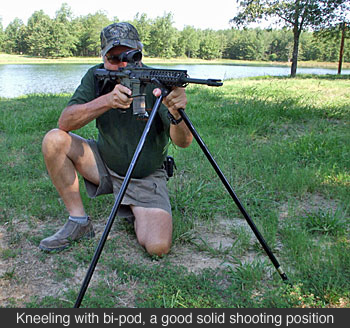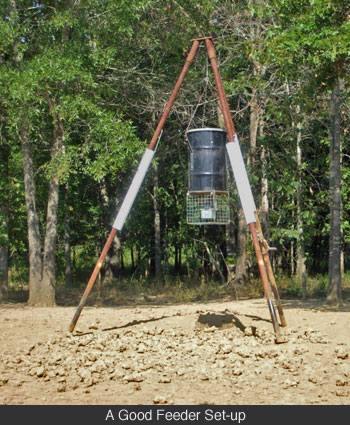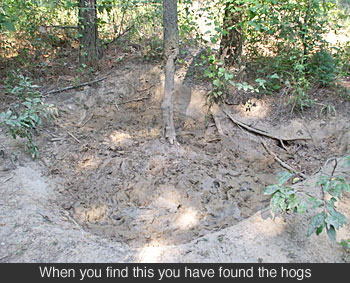There are four basic methods of hunting hogs: hunting over a feeder, spot and stalk, chasing them with dogs and using night vision. I’m not into dog hunting and know very little about it. Going tactical with night vision will be the topic of another article, so this article will focus on the other two methods.

First, always keep in mind the basics of hunting an animal. Whether traditional hunting or tactical hunting, focus on the following tactics. Be conscious of the wind and use it to your benefit. This is extremely important when hog hunting since this is the main sense they use to stay altert to danger. Blow this tactic, and you won’t even see a hog. Stay concealed as much as possible and move slowly and be quiet. Be patient! Get as close to your quarry as possible and use a steady shooting position.I normally use a Stoney Point Expedition bipod from kneeling or standing depending on the terrain. Also remember the 1st rule of hog hunting: “The only thing you can count on when hog hunting is that you can’t count on anything.” Hog hunting is usually a constantly changing sport, and that’s part of the fun, part of the challenge. Expect the unexpected!!!
Hog hunting from a stand or blind overlooking a corn feeder may be the most efficient way to harvest a hog. The key here is to put your feeder in an area that has hogs. There must be water, food and cover fairly close by. Refer to my previous article on hog sign to pick the spot for your feeder. I’ve found that placing the feeder close to thick cover often gives the hogs more of a sense of security and they will feel more comfortable coming to the feeder. The obvious downside here is if you don’t drop the hog in its tracks with a spine or brain shot the fun starts…
Strategic placement of your stand/blind is often critical to your success. Obviously you want to be downwind and far enough away that you can get by with minor noise. In East Texas, I usually place a box blind to the southeast of the feeder for winter hunting. For the summer, I use an open stand northeast of the feeder. I’ve settled on a distance of 70-80yds from the feeder, this is close enough that most people can make a killing shot, yet far enough that you can get by with a little noise and movement.

We don’t do a lot of early morning hunting on the ranch because we’re often out late night hunting, so we don’t have our feeders throwing in the mornings. At the Circle WC Ranch, we use Fieldpro 5 timers and can recommend them without hesitation. We’ve tried several brands and found these to be the most reliable and best value. I like to set my timers to throw an hour and a half before last shooting light and again thirty minutes before last light. This makes for a 2 ½ hour hunt if you don’t use a light or have night vision. However we often use Texas Boars LED feeder lights and hunt a full hour past last light, in this case I’ll usually set the feeder to go off a third time right at dark.
The larger boars will normally come in late, so you often have to be patient and watch family groups first. Also don’t count on a big boar actually coming to the feeder – they are ruled by their sex drive and are often just cruising the feeders looking for a sow in heat (much like a teenager passing through Sonic). They often just come to the edge of the cover and look, so always watch the edges of the cover around the feeder. This is also a good place to kill a bobcat since they do the same thing as a boar, looking for a piglet instead of sex.
When you go to your stand be quiet and don’t walk close to the feeder. Hogs are often bedded down within easy earshot of your stand and any scent you put out lingers there for 5-6 hours. If you decide to shoot be quiet. Don’t just flick your safety off making a metallic sound. Move slowly into position.
In some areas of farmland where the hogs are plentiful and have not been pressured a lot, spot and stalk tactics can actually be spot and shoot (out of the vehicle window). On my ranch we don’t get a lot of these opportunities except for meat hogs and/or at night. We do most of our spot and stalk hunting on cattle ranch land with rolling hills with patches of cover scattered here and there.
The keys to success are to hunt areas where hogs frequent, spotting the hogs before they spot you. Finding areas where hogs frequent is where prior scouting for hog sign comes in.
For reconnaissance, we normally ride around in a Kawasaki mule scanning the distance for hogs, stopping at good vantage points to scan carefully with binoculars. This works well on large properties, but if your only hunting a few hundred acres you will want to be on foot walking into the wind.
 Once you have spotted hogs, it’s decision time: Is there is one you want to shoot? Observe them to see what they are doing. If they are steadily walking, they are headed somewhere for water, food or cover. In this case, they are very hard to catch up to. You wouldn’t think an animal with such short legs could cover more ground than you can in the same period of time, but just try to catch up to a moving group of hogs that has a few hundred yards head start, while you’re trying to be quiet and use cover!
Once you have spotted hogs, it’s decision time: Is there is one you want to shoot? Observe them to see what they are doing. If they are steadily walking, they are headed somewhere for water, food or cover. In this case, they are very hard to catch up to. You wouldn’t think an animal with such short legs could cover more ground than you can in the same period of time, but just try to catch up to a moving group of hogs that has a few hundred yards head start, while you’re trying to be quiet and use cover!
When I spot hogs, I make three assessments: Anything we want to shoot? What’s the wind doing? Are they feeding? Based on this information I will either pass or plan a stalk. For a successful stalk, come in from downwind, use cover, move slowly and be quiet. If the available cover and terrain permits, I usually try to get within 60-80yds for a precise shot. I don’t like chasing wounded hogs in the thick bottomland that makes up the entire east and south boundaries of the area I hunt.
To summarize, here are my hog hunting tips in bullet points:
- Do prior scouting for hog sign and locate where the hogs frequent. Hunt where the hogs are.
- Always be conscious of what the wind is doing, be quiet and move slowly.
- Be patient.
- Try to spot the hogs before they spot you.
- Sounds that are unnatural to the hog’s habitat will easily spook them. Metallic sounds from people fiddling with their gun or flicking their safety off is what I see most with clients.
- If you’re hunting over a feeder, go to your stand quietly and don’t put out any unnecessary scent close to the feeder.
- When it comes time to shoot, pick out the precise point on the front of the hogs shoulder you want to hit. Hog killing is precise shooting.
- Expect the unexpected, this is what makes hog hunting fun and exciting!
Field Pro Timers
http://www.fieldprogamefeeders.com/
Circle WC Ranch
Texas Boars LED Feeder Lights




Great article. Valuable tips.
Great article and very well explained. I believe in professionals so this is a very useful article for everyone. Many thanks for your share.
Hog hunting would be a blast! Both figuratively and literally!